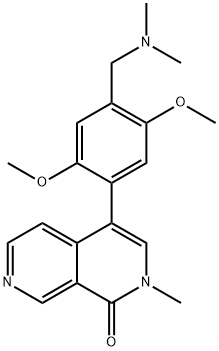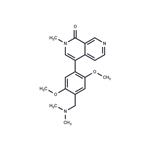Description
BI-9564 is a selective inhibitor of BRD9 and BRD7 bromodomains (K
ds = 14.1 and 239 nM; IC
50s = 75 nM and 3.4 μM, respectively) that demonstrates cellular activity by semi-quantitative FRAP assay with ~90% inhibition of BRD9 and BRD7 at 0.1 μM and 1 μM, respectively. It does not bind to other bromodomain-containing BET family members (IC
50s >100 μM as assessed by AlphaScreen), kinases, or G protein-coupled receptors and shows off-target selectivity only to the CECR2 bromodomain in
in vitro ITC assays (K
d = 258 nM), but not in cell-based assays at concentrations up to 1 μM. BI-9564 has been shown to inhibit the growth of EOL-1 AML cells both
in vitro (EC
50 = 800 nM) and in a disseminated mouse model of AML (180 mg/kg/day). See the
Structural Genomics Consortium (SGC) website for more information.
Uses
BI-9564 is a selective inhibitor of BRD9 and BRD7 bromodomains. It also exhibits antitumor activity in AML xenograft model. BI 9564 can be used as an epigentic probe to study bromodomain biology.
in vitro
bi-9564 was identified as a brd9/7 specific inhibitor via fragment-based screening and structure-guided design. bi-9564 was found to be bind to brd9 with a higher affinity than to brd7, and was negative on bet family proteins. in addition, bi-9564 demonstrated in vitro off-target selectivity to cecr2, but not in cells [1].
in vivo
in animal study, bomtac:nmrifoxn1nu mice were given two oral doses daily and the concentration of bi-9564 in plasma was measured. dose-dependent aucs were obtained for bi-9564, achieving exposures that were higher compared to the ec50 level for eol-1 cells. moreover, when the oral treatment with bi-9564 at 180 mg/kg was initiated on day 5 and applied daily with an interruption at day 18 and 19, a significant reduction in tumour growth compared to controls was found on day 18 leading to a median tumour growth inhibition value of 52% [1].
IC 50
75 nm and 3.4 μm for brd9 and brd7 bromodomains, respectively
References
[1] martin lj et al. structure-based design of an in vivo active selective brd9 inhibitor. j med chem. 2016 may 26;59(10):4462-75.


